In 2013 the various violin collections of Cremona were consolidated into one unified collection that is now housed in the new Museo del Violino. This museum, on the southeastern side of the city and located inside the building that once housed the technical school in which the first Cremona Violin Making School was based, has in one fell swoop become a must-see location for students of violin making and violin history. In the past, visitors to Cremona might have seen the collection at the Palazzo Comunale, which included the ‘Cremonese’, the only Stradivari in the collection of the city. Many were not aware of the other collections scattered around the town, so the new museum makes it far easier for the modern visitor to view these important instruments.
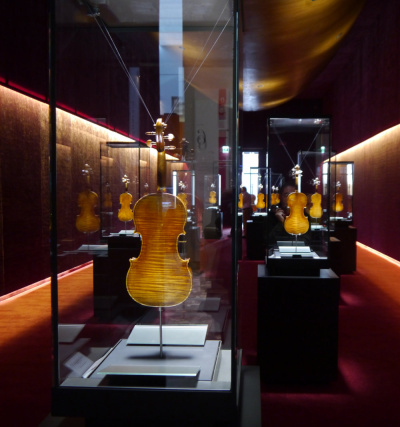
The 1715 ‘Cremonese’ Stradivari in the ‘Scrigno dei Tesori’ room of classical instruments
After entering the Museo and climbing the stairs to the first galleries, you reach a series of rooms that teach the origins and construction of violins. More informed visitors will probably pass by these displays to see the heart and soul of the Museo, ‘Lo Scrigno dei Tesori’ (the Treasure Chest). Part the heavy curtain covering a doorway and the first fine instrument comes into view: the ‘Cristiani’ Stradivari cello of 1700 (ID 40271). This truly magnificent instrument was justifiably among those chosen for the Stradivarius exhibition at the Ashmolean in 2013. Thickly and lavishly covered with a rich, deep, dark-red varnish, it shows sharp details of its maker’s intentions, especially in the chamfers of the scroll and the edges and corners of the body. A pair of frosted mirrors sit at its base, set to reflect light from above on to the lower bouts that would otherwise remain in shadow.
Behind it are representative examples by all the fine classical Cremonese masters. Their progression is chronological as one passes among the cases, each brightly lit with mirrored reflectors inside the darkened room in which they live. Next comes the ‘King Charles IX’ Andrea Amati (ID 42362), one of the oldest violins in the world and one that indelibly stamped the Amati family concept of what constituted a violin firmly on everything that was to follow. A fair quantity of its original decoration remains on the back and sides, and especially on the back of the scroll.
To the right stands a true rarity: a 1615 viola by Antonio and Girolamo Amati (ID 42170) that retains its original dimensions. This is a treat, because it is rare to see one so preserved and equally rare to appreciate the flowing and elegant lines that the makers intended for their model. It too is in fairly fresh and crisp condition (the person who began trying to fill the prominent flaw in the lower treble flank of the back fortunately chose to stop before any damage was done). Striking also are the long corners with purfling points that reach almost to the very tips. The rounded and delicate ‘f’s are among Girolamo’s sole alterations to the design his father conceived so completely 75 years before.
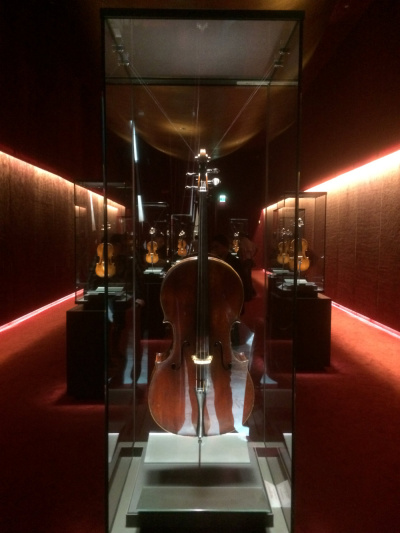
The ‘Cristiani’ Stradivari cello of 1700 in the ‘Scrigno dei Tesori’
Following the viola are two of Nicolò Amati’s creations, the ‘Hammerle’ of 1658 (ID 42363) and the ‘Collin’ of 1669. The ‘Hammerle’ brilliantly presents Nicolo’s Grand Pattern, although the effect is not so powerful as it might be had years of use not softened all the violin’s edges and corners. The ‘Collin’ shows what a difference a decade could make in the Amati shop, for its pattern is somewhat more subdued, its wood selection of fine quartered maple far less extravagant than the broad slab-cut wood of its predecessor, and the model too somewhat more reserved, reflecting perhaps the presence of the young Girolamo II, then turned 20, in his father’s workshop.
Next comes the art of another family, in the form of a fine later-period Francesco Rugeri. While there is not yet firm evidence of Rugeri having trained with the Amatis, the style of this violin suggests that, at the very least, he had a quite different idea of what to do. The outline and ‘f’s are stiffer, the ribs lower and the arching higher and more pinched, the wings quite a different shape, and the scroll, while essentially an Amati model, shows almost no attempt at hollowing through the cheeks. Francesco Rugeri had four sons who also became liutai; there is much, especially in the scroll, to suggest that his son Vincenzo may have had a hand in this violin.
Now come the Guarneris. On the left are father and son: an Andrea Guarneri of 1689 that shows the unmistakable craft of Giuseppe ‘filius Andrea’. The ‘Quarestani’ (ID 42364) is among the earliest of ‘filius’ violins known and shows the influence both of his father, in the shape of the arching and hollowing of the margins, and that of another forceful personality living a few doors away, in the general model and poise and placement of its ‘f’s. On the right is the ‘Zukerman, Lo Stauffer’ Guarneri ‘del Gesù’ (ID 40803), the violin on which Pinchas Zukerman began his career, and a typical example of the 1734 period. How extraordinary that the internal outline of this violin would match exactly that of his grandfather Andrea’s works, for indeed we believe that his form was one of Andrea’s, and yet the shape of the arching, corners and channeling shows such a different personality.
Next we reach the influential neighbor in one of his earliest expressions: the ‘Clisbee’ Stradivari of 1669 (ID 40733). Its model and ‘f’s, fastidious and even a bit fussy, lean more to Rugeri than Amati, but the scroll shows someone with his own mind and every intention of using it. The woods are good but simple, the varnish a plain gold, far less glamorous than a Grand Pattern Amati, but this is only the beginning of the journey.
It is almost shocking, as a result, to cross the room and be confronted by the ‘Vesuvius’ Stradivari of 1727 (ID 41535), a fine and mature late work, still showing its maker in full vigor, and once covered with a flaming deep red–orange varnish, some of which remains through the back C-bouts. The only concession to age is the ‘f’: the odd back turn of the holes suggests that Francesco was taking at least some of his father’s tasks in hand.
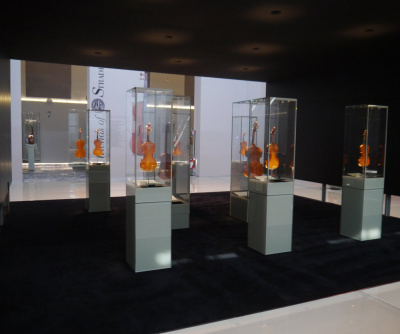
The second room of classical makers
Finally, we come to two excellent Golden Period violins, the 1714 ‘Joachim’ (ID 40496) and the 1715 ‘Cremonese’ (ID 40603). The ‘Joachim’ was its owner’s primary concert instrument through most of his career and probably premiered both Brahms’s first Violin Sonata and his great Violin Concerto. It shows many years of caring but active use, with some of its glowing varnish left to suggest what once was. Then one reaches the ‘Cremonese’ and sees what was missing: its varnish is in abundance, especially on the table, and broad patches still remain on the back. All its edges remain sharp and it is a fitting tribute to its master, a great and most inventive artist.
At the end of the room, another curtain separates the gallery from the light. Here we have a chance to see the tools themselves, and especially to see how carefully the master thought through what he wanted to do. These tools and forms of Stradivari remain the only fairly complete workshop to survive from any violin maker in the 17th or 18th century. These have come down to us thanks to the largesse and intelligence of the violin maker Giuseppe Fiorini, and so it is only appropriate that his work should also be present, in the form of one of his later-period violins on the Stradivari model.
The forms and patterns are no longer displayed in badly lit and conserved cases. Today they are housed in sliding drawers, well conserved, and positioned so as to explain Stradivari’s violin making process for each of the forms so represented. LCD wall displays digitally take the pieces and reposition them to show how they were actually used by the master.
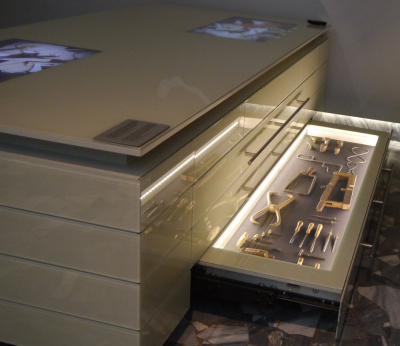
The Stradivari workshop tools are displayed in sliding drawers
Next to you at this stage is a long covered gallery panelled in rich hardwoods, inside which is a collection of more classic instruments. These have been assembled by the Friends of Stradivari from various other sources, including the Henry Ford Foundation and the Axelrod Foundation, the former having loaned the ‘Rougemont’ Stradivari of 1703 (ID 40478) and the latter the ‘Hellier’ Stradivari of 1679 (ID 40237).
Behind them stand three works from the late Cremonese makers: a Lorenzo Storioni, a G.B. Ceruti and an Enrico Ceruti. Of these, one should pay particular attention to the two Ceruti, for the grandfather’s work of 1802 is a small violin that still retains its original neck, in its original unaltered placement, and its fingerboard and fittings are at the very least of the same period. It shows almost no wear and as such reveals what Ceruti intended. Perhaps even more astonishing is the Enrico, a later work of 1868. It too has its original neck, fingerboard and fittings, but while the neck was set in the same method as that in his grandfather’s violin, it is now a modern neck, with a modern length and angle. The fine varnish also chips and adheres to the wood in a much more modern manner, so that it has more in common with early 20th-century work than it does with that of his ancestors.
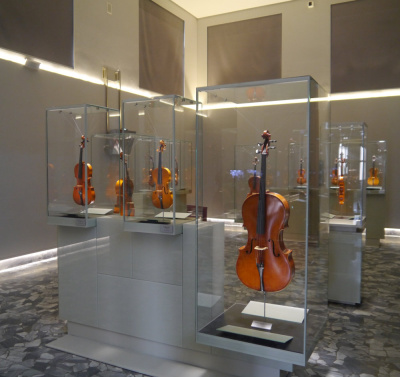
The 20th-century room houses instruments from Cremona’s great competitions of 1937 and 1949
In the adjacent galleries, homage is paid to the more modern makers with whom Cremona is connected. The city created two great competitions of violin making in the 20th century, one in 1937 and the other in 1949, as a vehicle to promote the craft in Cremona, but these exhibitions most effectively promoted the other modern Italian makers working elsewhere in the country. It is not well known that the city retained many of the instrument sets submitted for competition, particularly many of those that won prizes, and so Cremona today owns quartets by such makers as Ornati, Garimberti, Bisiach, Candi, Lecchi and many more, all as fresh as when their makers presented them for assessment. Unfortunately, space does not permit them all to be displayed simultaneously, but generally one instrument from each ensemble is displayed. This space is also set aside for temporary exhibitions.
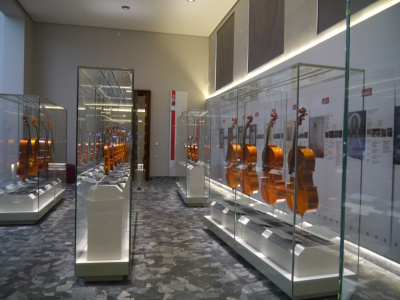
The Triennale competition instruments form a ‘who’s who’ of international modern violin making
Modern visitors perhaps know Cremona’s violins best from the Triennale, the violin making competition the city has held every three years since 1972. The winning instruments from each competition are retained by the city and these are now all on display, and the international origins of the various gold-medal winners turn the collection into a ‘who’s who’ of modern violin making worldwide.
In short, there is much to study when visiting the Museo del Violino. Be sure to take a museum booklet, and don’t forget a pad on which to take the copious notes that will help you to recall all that you’ve seen there.
Philip J. Kass is a respected expert on classical violin making and has written extensively for the Journal of the Violin Society of America, The Strad magazine and other periodicals, as well as contributing many entries to the New Grove Dictionary of Music.